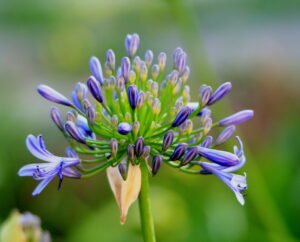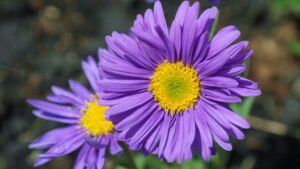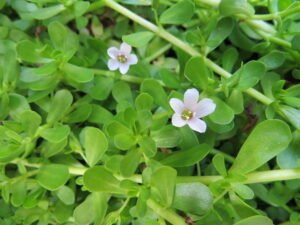Caryopteris (Bluebeard): How To Plant And Care

Caryopteris A Flowering Shrub
Caryopteris, also known as Bluebeard, Blue Spirea, or Blue Mist, is a beautiful flowering shrub. Native to East Asia, these deciduous shrubs are known for their beautiful blue, purple, or white flowers that bloom in late summer and early fall. It is prized for its vibrant flowers and attractive foliage, making it a popular choice among gardeners. In this article, we will provide you with all the information you need to successfully plant and care for caryopteris in your garden.

Caryopteris belongs to the plant family Lamiaceae, which includes other well-known plants like mint and lavender. Caryopteris produces clusters of small, tubular flowers in shades of blue, purple, or white. These flowers attract butterflies, bees, and other pollinators, making them a wonderful addition to any pollinator garden.
Popular Varieties Of Caryopteris
1. Caryopteris x clandonensis ‘Heavenly Blue’
One of the most well-known varieties of caryopteris is ‘Heavenly Blue’. This cultivar features stunning deep blue flowers that bloom from late summer to early fall. The blooms are a wonderful addition to pollinator gardens since they draw bees and butterflies. ‘Heavenly Blue’ grows to a height of around 2-3 feet and has a compact, mounding habit. It is a hardy plant that is drought-tolerant and deer-resistant, making it perfect for low-maintenance landscapes.
2. Caryopteris x clandonensis ‘Sunshine Blue’
Another popular variety of caryopteris is ‘Sunshine Blue’. This cultivar is known for its golden yellow foliage, which contrasts beautifully with the blue flowers. ‘Sunshine Blue’ blooms from mid-summer to early fall and attracts pollinators like bees and butterflies. It has a compact growth habit, reaching a height of about 2-3 feet. This variety is also drought-tolerant and deer-resistant, making it a great choice for xeriscapes and wildlife gardens.
3. Caryopteris divaricata
Caryopteris divaricata, also known as Spreading Bluebeard, is a native variety that is found in the wild in China and Japan. This species has a more spreading habit compared to other caryopteris varieties, making it a great groundcover or border plant. It features pale blue flowers that bloom from late summer to early fall. Caryopteris divaricata is a low-maintenance plant that is drought-tolerant and attracts pollinators. It grows to a height of around 2-3 feet and spreads up to 4-6 feet.
Facts About Caryopteris
Caryopteris is native to East Asia, specifically China and Japan. This deciduous shrub typically grows to a height of 2-4 feet and has a rounded or mounded shape. The leaves are aromatic, with a gray-green color and a lanceolate shape. What truly sets Caryopteris apart is its stunning blue flowers that bloom in late summer and continue into the fall.
The genus Caryopteris was first described by the Scottish botanist George Don in 1834. Don named it after the Greek words “karyon” meaning nut and “pteron” meaning wing, referring to the winged nutlets that are characteristic of the plant. The species Caryopteris incana was the first to be discovered and described.
It wasn’t until the early 20th century that Caryopteris gained popularity in the gardening world. Japanese nurserymen began cultivating and hybridizing different varieties, leading to the introduction of several new and improved cultivars. These cultivars showcased a wider range of flower colors, foliage variations, and growth habits, making Caryopteris a sought-after plant for garden enthusiasts.
Caryopteris is a deciduous shrub that typically grows to a height of 2 to 4 feet and has a similar spread. It has an upright, bushy habit with slender, arching branches. The leaves are opposite, simple, and lance-shaped, with a gray-green color that adds an attractive contrast to the garden. The foliage emits a pleasant fragrance when crushed, making it a delightful addition to any garden.
Caryopteris is a hardy plant that can adapt to a wide range of climates. It is suitable for USDA hardiness zones 5-9, which covers a large portion of the United States. Whether you live in a hot and dry desert region or a cooler, more temperate area, Caryopteris can thrive in your garden. However, in colder climates, it may require some winter protection, such as mulching around the base of the plant, to prevent frost damage.
Caryopteris is known for its exceptional drought tolerance, making it an ideal plant for regions with limited water availability. Once established, it can thrive in dry conditions and requires minimal watering. This makes it a great choice for xeriscaping or for gardeners who prefer low-maintenance plants. However, it’s important to note that while Caryopteris can tolerate drought, it still benefits from occasional watering during prolonged dry spells.
Due to its compact size and attractive flowers, Caryopteris can be used in various ways in your garden. It works well as a border plant, creating a beautiful edge along pathways or garden beds. You can also plant it in groups or clusters to create a striking mass of blue blooms. Caryopteris can even be grown in containers, making it a versatile choice for small gardens or balconies. Its vibrant color and unique texture add visual interest to any landscape.
If you live in an area with deer population, you know the struggles of finding plants that these animals won’t devour. Fortunately, Caryopteris is considered deer resistant. Deer tend to avoid plants with aromatic foliage, such as Caryopteris, as the strong scent deters them from feeding on it. This makes Caryopteris a great option for gardens located in deer-prone areas, allowing you to enjoy its beauty without the worry of constant deer damage.
FAQ About Caryopteris
When does Caryopteris bloom?
Caryopteris typically blooms from late summer to early fall, adding a burst of vibrant blue color to your garden when many other plants are starting to fade. The flowers are small, but they are produced in large clusters, creating a stunning display.
How tall does Caryopteris grow?
Caryopteris shrubs are generally compact and grow to a height of around 2 to 3 feet (60 to 90 cm). However, there are some varieties, such as Caryopteris x clandonensis ‘Longwood Blue,’ that can reach up to 4 to 5 feet (120 to 150 cm) in height. Make sure to choose a variety that suits the available space in your garden.
Can Caryopteris be grown in containers?
Yes, Caryopteris can be grown in containers, making them a versatile choice for small gardens, balconies, or patios. When growing Caryopteris in containers, make sure to choose a large enough pot to accommodate the root system. To keep the soil consistently moist, use a potting mix that drains well and give it regular waterings.
Is Caryopteris Toxic?
Fortunately, Caryopteris is not considered to be toxic to humans or animals. According to the American Society for the Prevention of Cruelty to Animals (ASPCA), Caryopteris is classified as non-toxic to dogs, cats, and horses. This means that if your pet accidentally ingests a small amount of Caryopteris, it is unlikely to cause any serious harm.
How long does Caryopteris live?
Caryopteris is a perennial plant, meaning it will come back year after year. On average, Caryopteris can live for about 5 to 10 years. However, with proper care and maintenance, it is possible for these shrubs to live even longer. The lifespan of Caryopteris can be influenced by various factors such as climate, soil conditions, and pruning practices.
Is Caryopteris Evergreen or Deciduous?
Caryopteris is deciduous. This means that it will shed its leaves in the fall and remain bare throughout the winter months. Although Caryopteris is deciduous, it is a hardy plant that can withstand cold temperatures and harsh winter conditions. In fact, it is often recommended for gardeners in colder climates, as it is known to be quite resilient.
Is Caryopteris a Sun or Shade Plant?
Caryopteris plants thrive in full sun, which means they require at least six hours of direct sunlight per day. Placing them in a sunny spot will ensure they receive the necessary light to grow and bloom abundantly. If you have a garden or a sunny area in your yard, it would be the perfect location for Caryopteris.
How To Plant Caryopteris
Right Time
The ideal time to plant caryopteris is either in the spring or fall. These seasons provide the best conditions for the shrub to establish its roots and thrive. In the spring, aim to plant caryopteris after the last frost date in your area. This will give the plant plenty of time to settle in before the hot summer months. Fall planting is also a great option for caryopteris. Planting in the early fall, around 6 to 8 weeks before the first frost date, allows the shrub to establish its roots before winter sets in. The cool temperatures and ample rainfall of the fall season provide optimal conditions for the plant to grow strong and healthy.
Right Location
Before you start planting Caryopteris, it is important to choose the right location in your garden. Caryopteris thrives in full sun and well-drained soil. It is best to select a spot that receives at least 6 hours of direct sunlight per day. Avoid planting Caryopteris in areas with heavy clay soil or poor drainage, as this can lead to root rot.
When it comes to soil pH, Caryopteris prefers slightly acidic to neutral soil. You may lower the pH of your soil if it’s excessively alkaline by amending it with organic materials, like compost or peat moss. It is also a good idea to perform a soil test to determine the pH level and make any necessary adjustments before planting.
Preparing the Soil
After deciding on a spot, you need to get the soil ready for Caryopteris planting. Remove any weeds or grass from the area. Loosen the soil using a garden fork or tiller, breaking up any clumps and removing rocks or debris.
If your soil is heavy or compacted, you can improve its drainage by adding organic matter such as compost or aged manure. Spread a layer of organic matter over the planting area and mix it into the soil using a garden fork or tiller. This will help improve the soil structure and provide essential nutrients for the Caryopteris plant.
Planting Caryopteris
Now that your soil is prepared, it’s time to plant Caryopteris. Start by digging a hole that is slightly larger and deeper than the root ball of the plant. With extreme caution to avoid damaging the roots, carefully remove the plant from its container.
Place the plant in the hole, making sure that the top of the root ball is level with the surrounding soil. To eliminate any air pockets, gently compact the earth surrounding the roots as you backfill the hole. Water the plant thoroughly after planting to settle the soil and ensure good root-to-soil contact.
Space Caryopteris plants about 2 to 3 feet apart, as they can grow up to 3 feet in height and spread. This will allow enough room for the plants to grow and fill out without overcrowding each other.
How To Care For Caryopteris
Sunlight
Caryopteris plants need at least 6 to 8 hours of direct sunlight each day. This means they should be planted in a location that receives full sun, where they can bask in the warm rays of the sun. Without sufficient sunlight, the plant may become weak and leggy, and its blooms may be less vibrant.
Soil
Caryopteris prefers well-drained soil that is not too heavy or waterlogged. It thrives in soil that allows excess water to drain away, preventing the roots from becoming waterlogged and susceptible to rot. Sandy or loamy soil types are ideal for caryopteris, as they provide good drainage. Caryopteris prefers slightly acidic to neutral soil with a pH level between 6.0 and 7.0. It is important to test the soil’s pH level and make any necessary adjustments to ensure optimal growing conditions for the plant. Adding organic matter, such as compost or well-rotted manure, can help improve the soil’s pH level.
Watering
Proper watering is essential for the health and well-being of caryopteris. While it is a relatively drought-tolerant plant, it still requires regular watering, especially during dry periods. It is important to water deeply and thoroughly, ensuring that the water reaches the roots of the plant.
A good rule of thumb is to water your caryopteris when the top inch of soil feels dry to the touch. Refrain from overwatering as this can cause other problems, such as root rot. It is also important to note that caryopteris does not tolerate standing water, so be sure to choose a well-drained location and avoid overwatering.
Fertilizing
It is best to fertilize your Caryopteris plants in the early spring, just as new growth begins to emerge. This will provide the plants with the necessary nutrients to support healthy growth and abundant blooms throughout the growing season.
When selecting a fertilizer for your Caryopteris plants, choose a balanced, slow-release fertilizer with a ratio of 10-10-10 or 14-14-14. This will provide a good balance of essential nutrients, including nitrogen, phosphorus, and potassium. Additionally, look for a fertilizer that contains micronutrients such as iron, manganese, and zinc, which are important for overall plant health.
Before applying the fertilizer, water your Caryopteris plants thoroughly to ensure that the soil is moist. Then, sprinkle the fertilizer evenly around the base of the plant, avoiding direct contact with the stems or foliage. Use a garden fork or rake to lightly work the fertilizer into the top layer of soil. Finally, water the plants again to help the nutrients penetrate the soil.
It is important not to over-fertilize your Caryopteris plants, as this can lead to excessive foliage growth at the expense of blooms. Follow the instructions on the fertilizer packaging for the recommended amount to use, and avoid applying more than the recommended dosage.
Pruning
The best time to prune Caryopteris is in early spring, just before new growth begins. This allows the plant to recover quickly and encourages healthy growth throughout the growing season. However, if you have neglected pruning your Caryopteris, don’t worry! You can still prune it in late winter or early spring, but be aware that you may sacrifice some of the early blooms.
Start by removing any dead or damaged branches. This will stop illnesses from spreading and enhance the plant’s overall beauty. Next, selectively prune back about one-third of the plant’s height. Focus on removing older wood and thinning out crowded areas to improve air circulation.
When pruning, make clean cuts just above a bud or side branch. Avoid cutting too close to the main stem, as this can cause damage. If you want to maintain a more compact shape, you can prune Caryopteris more heavily, but be careful not to remove too much foliage.
Common Pests and Diseases
While caryopteris is relatively resistant to pests and diseases, it can still be susceptible to certain issues.
Aphids
Aphids are small, sap-sucking insects that can infest caryopteris plants. They can be controlled by spraying the affected plant with a strong jet of water or by using insecticidal soap.
Powdery Mildew
Powdery mildew is a fungal disease that can affect caryopteris, causing a white powdery coating on the leaves. Make sure the plant has adequate air circulation, and refrain from watering it from above to prevent powdery mildew. If necessary, treat with a fungicide according to the instructions.
Root Rot
Overwatering or poorly draining soil can lead to root rot in caryopteris plants. To prevent this, ensure that the soil is well-draining and avoid overwatering. If root rot occurs, remove the affected plant and improve the soil drainage before replanting.
Winter Care
If you live in an area that experiences frost or freezing temperatures, it’s important to take steps to protect your caryopteris plants. One option is to cover the plants with a frost cloth or blanket. This will help to trap heat and create a microclimate around the plant, providing some protection from the cold. Another option is to create a simple frame using stakes and cover it with plastic or burlap to create a makeshift greenhouse. This can provide additional protection from frost and cold winds.
Applying a layer of mulch around the base of your caryopteris plants can help to insulate the roots and protect them from freezing temperatures. Use a layer of organic mulch, such as wood chips or shredded bark, and spread it around the base of the plant to a depth of 2-3 inches. Be careful not to pile the mulch up against the stem of the plant, as this can create a moist environment that can lead to rot.
Caryopteris, or bluebeard, is a stunning flowering shrub that can bring beauty and color to any garden. By choosing the right location, planting correctly, and providing the proper care, you can enjoy the vibrant blue flowers and attractive foliage of caryopteris for years to come. Remember to water, fertilize, prune, and protect your plant, and watch out for any potential pests or diseases. With a little bit of effort, you can create a thriving caryopteris garden that will be the envy of your neighbors.





